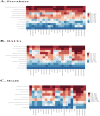Analyzing the global burden of 11 subtypes of congenital birth defects: trends, sociodemographic correlates, and outcomes from 1990 to 2021
- PMID: 40528359
- PMCID: PMC12372484
- DOI: 10.1080/07853890.2025.2519686
Analyzing the global burden of 11 subtypes of congenital birth defects: trends, sociodemographic correlates, and outcomes from 1990 to 2021
Abstract
Background: Congenital birth defects (CBDs) significantly affect child mortality and disability worldwide, yet regional understandings of their burden and contributing factors remain poorly defined. This study examines global trends in prevalence, disability-adjusted life years (DALYs), and mortality related to CBDs and their 11 subtypes from 1990 to 2021.
Methods: Employing data from the Global Burden of Disease Study 2021, this cross-sectional analysis covers CBD prevalence, mortality, and DALYs among children aged 0-14 years. It also investigates relationships between these trends and the Socio-Demographic Index (SDI), employing advanced statistics like Joinpoint regression and heatmap analyses to elucidate geographic variations.
Results: From 1990 to 2021, global trends in CBD prevalence, mortality, and DALYs generally decreased. The neonatal period (<28 days) presented the highest risk, with notable prevalence, mortality, and DALY rates. Among the 11 subtypes, congenital musculoskeletal and limb anomalies were most prevalent, while Turner syndrome was least common. Congenital heart anomalies recorded the highest mortality and DALYs. There was a negative correlation between CBD burden and SDI.
Conclusion: The study underscores the global impact of CBDs on child health, pointing to significant regional disparities linked to socioeconomic factors. The findings advocate for enhanced prevention and management strategies specifically designed for regions with lower SDIs.
Keywords: Congenital abnormalities; disability-adjusted life years; epidemiology; global burden of disease; socioeconomic factors.
Plain language summary
The prevalence, mortality, and DALYs attributable to congenital birth defects (CBDs) significantly decreased globally from 1990 to 2021, though notable regional disparities persist.A negative correlation was observed between the burden of CBDs and the Socio-Demographic Index (SDI), highlighting the role of socioeconomic development in reducing disease burden.The neonatal period (<28 days) remains the critical window for addressing CBD burden, emphasizing the need for enhanced early screening and intervention programs globally.
Conflict of interest statement
No potential conflict of interest was reported by the author(s).
Figures




Similar articles
-
Global, regional, and national epidemiology of childhood Burkitt Lymphoma from 1990 to 2021: statistical analysis of incidence, mortality, and DALYs.Front Public Health. 2025 Jul 16;13:1560003. doi: 10.3389/fpubh.2025.1560003. eCollection 2025. Front Public Health. 2025. PMID: 40740379 Free PMC article.
-
Mapping the global burden of early-onset Parkinson's disease: socioeconomic and regional inequalities from the Global Burden of Disease Study 2021.Front Public Health. 2025 Jul 22;13:1618533. doi: 10.3389/fpubh.2025.1618533. eCollection 2025. Front Public Health. 2025. PMID: 40766033 Free PMC article.
-
Hepatoblastoma regional trends: dynamic SDI & joinpoint regression analysis.BMC Cancer. 2025 Jul 5;25(1):1148. doi: 10.1186/s12885-025-14566-2. BMC Cancer. 2025. PMID: 40618033 Free PMC article.
-
Global, regional, and national burden of maternal disorders, 1990-2021: a systematic analysis from the global burden of disease study 2021.BMC Public Health. 2025 Jul 29;25(1):2576. doi: 10.1186/s12889-025-23814-w. BMC Public Health. 2025. PMID: 40730990 Free PMC article.
-
Global burden and risk factors of musculoskeletal disorders among adolescents and young adults in 204 countries and territories, 1990-2019.Autoimmun Rev. 2023 Aug;22(8):103361. doi: 10.1016/j.autrev.2023.103361. Epub 2023 May 23. Autoimmun Rev. 2023. PMID: 37230312 Review.
References
-
- Madrid L, Vyas KJ, Kancherla V, et al. Neural tube defects as a cause of death among stillbirths, infants, and children younger than 5 years in sub-Saharan Africa and southeast Asia: an analysis of the CHAMPS network. Lancet Glob Health. 2023;11(7):e1041–e1052. doi: 10.1016/S2214-109X(23)00191-2. - DOI - PMC - PubMed
MeSH terms
LinkOut - more resources
Full Text Sources
Other Literature Sources
Medical
